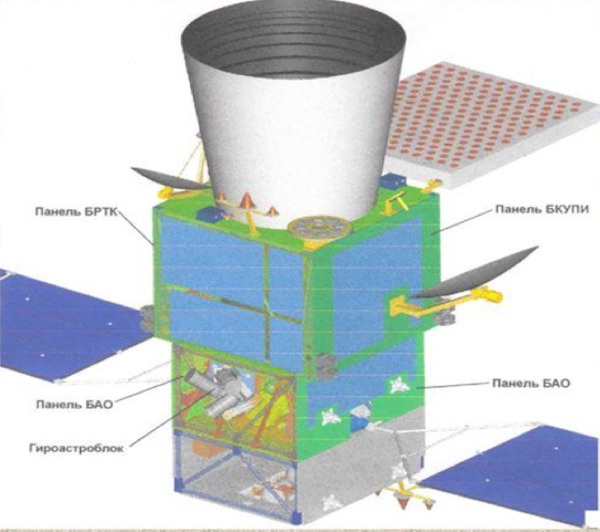EKS: Russia’s space-based missile early warning systemby Bart Hendrickx
|
| A combination of first and second-generation satellites continued to be launched until early last decade, relying largely on a stockpile of hardware left over from the Soviet days. |
One disadvantage of this viewing geometry was that the satellites could easily be blinded by the light of the setting Sun. This triggered at least one false missile attack alarm in September 1983, which fortunately enough was recognized as such by the officer on duty at the Soviet ground control station. When the incident was disclosed after the end of the Cold War, the duty officer (Stanislav Petrov) received several international awards for his role in averting a nuclear catastrophe. Still, the alarm could well have been called off higher up in the chain of command in the absence of corroborative data from ground-based early warning radars.
A second generation of early warning satellites (US-KMO), introduced in 1991, was designed to provide global coverage from geostationary orbit. Equipped with upgraded sensors, they were capable of seeing missile launches against the background of Earth, including submarine-launched ballistic missiles. However, many of the satellites failed early and there were some reports claiming that their sensors performed below expectations.
The prime contractor for the first two generations of space-based early warning systems was TsNII Kometa (renamed the Kometa Corporation in 2012), which carried out the same role for Soviet ocean reconnaissance satellites and anti-satellite projects. The actual integration of the satellites was in the hands of NPO Lavochkin, which has also built all the country’s planetary and lunar probes. Payloads were infrared scanning sensors of the Vavilov State Optical Institute (GOI) and infrared television cameras (so-called “staring sensors”) of the Scientific Research Institute of Television (NIIT). The scanning sensors could scan wide fields of view to detect missile launches and the more sensitive staring sensors were better at zooming in on targets and determining their trajectories.[1]
The birth of EKS
A combination of first and second-generation satellites continued to be launched until early last decade, relying largely on a stockpile of hardware left over from the Soviet days. The economic crisis that engulfed Russia in the 1990s made it impossible for the country to initiate any new early warning satellite projects until the turn of the century. In 1999, plans were announced for a new constellation of early warning satellites known as the Integrated Space System (EKS), which would consist of both HEO and GEO satellites. Kometa was again assigned as prime contractor, receiving a contract for EKS from the Ministry of Defense on March 15, 2002. Several companies appear to have vied for the role of satellite manufacturer, including NPO Lavochkin and the Khrunichev Center. However, on March 18, 2004, Kometa’s choice fell on RKK Energiya, the former Korolyov design bureau, best known as a manufacturer of space stations and the Soyuz and Progress spacecraft.[2]
EKS is also known by the military index 14K032 and has recently also been referred to by several officials as Kupol (meaning “dome”). These are names for the entire system, comprising not only the HEO and GEO satellites, but also the ground control segment, the launch vehicles and cosmodrome infrastructure. The HEO satellites are called Tundra and have the military index 14F142. No names or indices have so far been given for the GEO satellites.
The Tundra satellites
A fairly good understanding of Tundra’s design can be obtained from a number of sources, some more elusive than others. Kometa has even released one picture and at least three drawings of the satellite and although these were not specifically identified as showing Tundra, the project clearly has a somewhat lower classification level than many other Russian military space projects (the same, incidentally, applies to American early warning satellites).
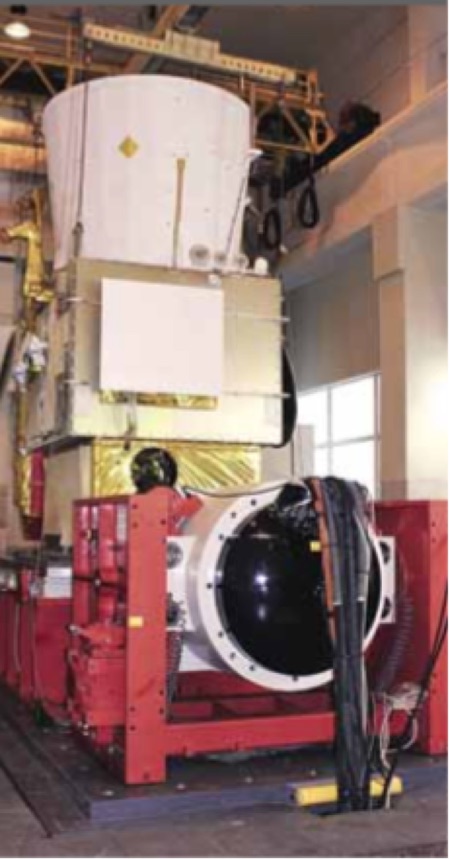 The only publicly available picture of a Tundra satellite, published in a Kometa article in 2017. Source |
The Tundra satellites are launched into Molniya-type orbits by Soyuz-2.1b rockets with the Fregat upper stage from the Plesetsk Cosmodrome in northwestern Russia. They have a service module (or “bus”) referred to in RKK Energiya publications as the Universal Space Platform (UKP) or Viktoriya, derived from that used by the company’s Yamal communications satellites. This is a three-axis stabilized platform that can be tailored for flights in Sun-synchronous, highly elliptical, and geostationary orbits, which may have been a decisive factor in selecting RKK Energiya as the satellite manufacturer. Unlike Soviet satellites, the UKP platform does not use a pressurized compartment to provide a controlled environment to the on-board electronics. The dry mass of the UKP bus ranges from 950 to 1,200 kilograms. The payload mass for HEO satellites is between 500 and 1,000 kilograms and for GEO satellites between 250 and 300 kilograms. The design lifetime is given as at least 7.5 years for the HEO satellites and up to 12.5 years for the GEO satellites. This is probably due to the fact that HEO satellites regularly pass through the Van Allen radiation belts.[3]
| Unlike their Soviet predecessors, the Tundra satellites should have enough computing power to do much of the data processing on board, allowing operators on the ground to make swift recommendations to the country’s leadership. |
Little is known about the specific adaptations made to Tundra’s service module. It may have the index 14S022, which shows up in some documentation related to EKS and is linked to a “combined engine unit” (a term usually used for a liquid propellant engine system), star trackers and reaction wheels.[4]
Much more information is available on Tundra’s payload module (known by the Russian acronym MTsA). Two exploded views of the module show the general layout of its systems.
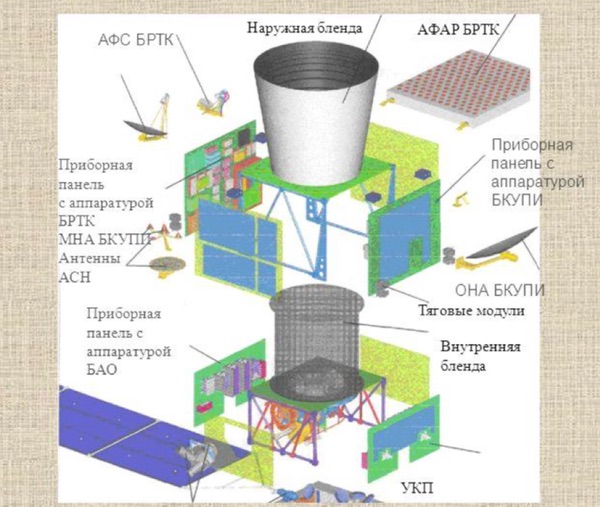 Exploded view of Tundra’s payload module. Source |
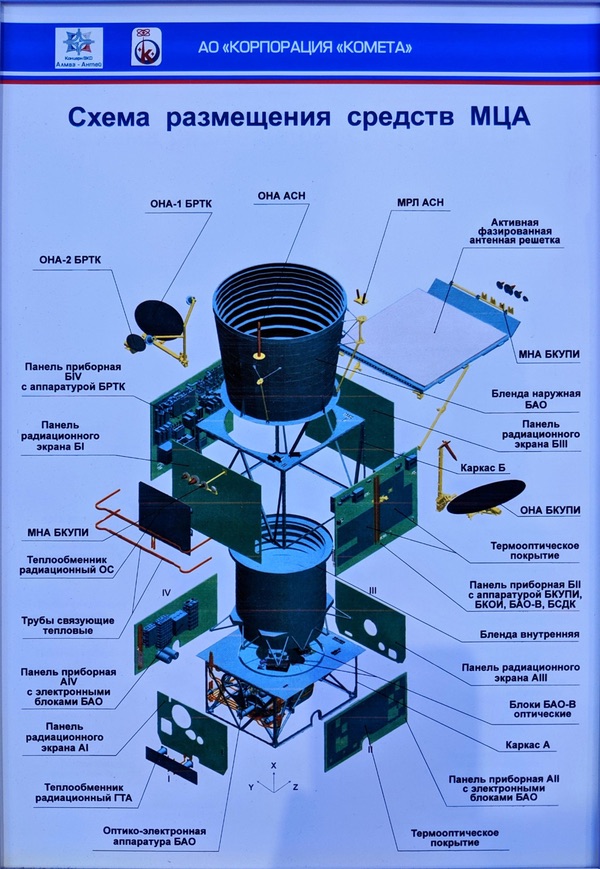 Another exploded view of Tundra’s payload module released by Kometa in 2019. |
It consists of two sections designated “A” (the lower section) and “B” (the upper section). The structural frame, honeycomb panels, and radiators are provided by NPO Lavochkin.[5] Mounted on the upper section are at least two (and probably four) arrays of electric thrusters. These are known to be SPD-100 Hall-effect ion thrusters (called “stationary plasma thrusters” in Russian terminology) of OKB Fakel that have flown on many Russian and non-Russian satellites. Weighing 3.5 kilograms, each of the engines has a thrust of 83 millinewtons and a specific impulse of 1600 seconds. [6] They probably assist in countering some of the perturbations to which Molniya-type orbits are susceptible due to the oblateness of the Earth and gravitational effects from the Moon and the Sun.
Extending from the payload section are a number of antennas used for a variety of functions. One is a set of satellite navigation antennas (ASN) manufactured by the Yaroslavl Radio Factory that should help accurately determine the satellites’ orbital parameters.[7] Also seen are steerable and phased array antennas of the On-Board Radio Communications System (BRTK) and low-gain and high-gain antennas of the On-Board Control and Data Transmission System (BKUPI). These systems are likely used to process the data gathered by the payload and send it to Earth.
Unlike their Soviet predecessors, the Tundra satellites should have enough computing power to do much of the data processing on board, allowing operators on the ground to make swift recommendations to the country’s leadership on the need to activate anti-ballistic missile systems or launch a retaliatory strike. The satellites may also be integrated into the communication network needed to ensure a quick response to a missile attack. According to some sources, the full name of EKS actually is the “Integrated Space System for Detection and Battle Management” (EKSOiBU), because it combines the missile detection functions performed by early warning satellites and some of the strategic communications functions of the earlier Molniya-type communications satellites. A key player in the development of these systems appears to be NPO Impuls, a company whose core business is to supply automated battle management systems to the Strategic Missile Forces. NPO Impuls signed a contract with Kometa for EKS on August 1, 2007, and related documentation refers to onboard systems called 15E1827, 14R735, and 15N1953 that include at least one computer. Some of the work seems to have to do with the protection of downlinked and/or uplinked information.[8]
The payload itself is called the On-Board Detection Equipment (BAO) and occupies both sections of the payload module, with a sun shade mounted on the upper part to prevent stray light from entering the telescope. Nothing has been officially revealed about the nature of the payload, but one document related to EKS refers to a system called Irtysh-E with what is literally called a “wide-angle channel” and a “narrow-angle channel”.[9] This is almost certainly a modified version of the dual-channel Irtysh infrared telescope conceived at the NIIT institute in the late 1980s for the second-generation US-KMO satellites. Irtysh was outfitted with cryogenically cooled video camera tubes (vidicons) of TsNII Elektron that were more sensitive than the uncooled vidicons flown on the first-generation satellites. They should have been able to detect missile launches against any type of background, but for some reason the US-KMO satellites only carried infrared scanning payloads.
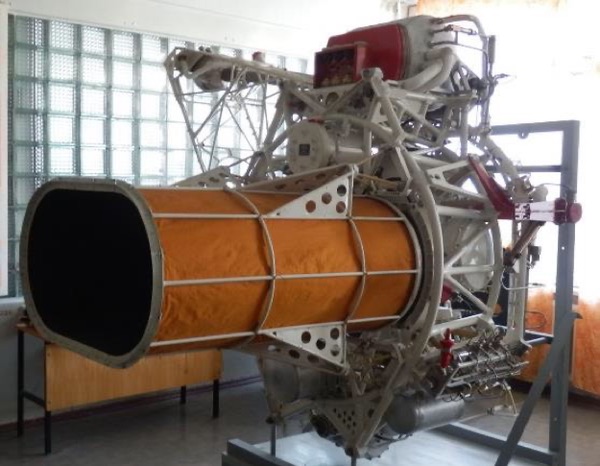 The Soviet-era Irtysh telescope. Source |
Despite the rapid advance of lightweight solid-state image sensors (particularly CCDs), it is clear that plans to fly Irtysh were not given up even after the turn of the century. A NIIT article published in 2015 said its development had been dragging on for 30 years, a sure sign it was still under development at the time.[10] Furthermore, Kometa and TsNII Elektron signed a contract for the delivery of vidicons for EKS on July 2, 2001, which was even before the official start of the project. The vidicons are designated LI489E and are manufactured under a joint effort between the two companies known as Kater-3E.[11] LI489E is described in one TsNII Elektron paper as being based on so-called A3B5 semiconductors and capable of operating at wavelengths up to 3 microns.[12] It had a forerunner called LI489 which can be traced to a Soviet early warning satellite program of the 1980s based on a PhD dissertation on infrared vidicons published in 2001.[13] In short, there is ample evidence that Irtysh-E and LI 489E are modernized versions of identically named hardware developed in the early 1980s, with the letter “E” added to indicate it was adapted for EKS.
| There are strong indications that the geostationary satellites will be equipped with a new payload. |
So why did the Russians decide to stick to this seemingly outdated technology? The aforementioned PhD dissertation claims that cryogenically cooled infrared vidicons still have a better performance than solid-state sensors, are cheaper to produce, and can better withstand radiation, singling out the LI489 vidicon as an example of that. On the other hand, a Kometa paper published in 2016 said the further development of infrared vidicons for “space-based detection systems” had been terminated because they don’t meet today’s requirements for “reliability, mass and size” and also because of their insufficient sensitivity and the low number of pixels used.[14]
Irtysh-E’s two “channels” should allow the telescope to operate in both wide-angle and narrow-angle mode. The optical instruments needed for this are provided by a daughter company of Kometa called the Scientific Research Institute for Optical and Electronic Instrument Building (NII OEP). Photographs of these instruments were available on Kometa’s website until recently.
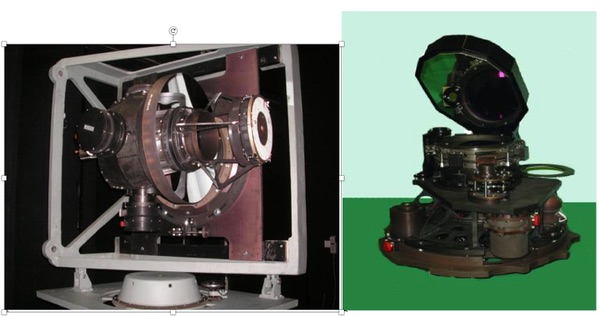 Narrow-angle (left) and wide-angle optical systems of the Irtysh-E camera. Source: Kometa website. |
The payload has a cryogenic cooling system developed by the Nudelman Design Bureau of Precision Engineering (KB Tochmash), also known for its involvement in several anti-satellite projects. A press release that appeared on the company’s website in October 2017 noted that the system had been successfully tested on the second Tundra satellite.[15] Publicly available annual reports of KB Tochmash refer to the system as SGO-RF. A patent filed by KB Tochmash in 2016 describes a space-based cooling system that almost certainly is the one designed for Tundra. It has two so-called Stirling closed-cycle cryogenic coolers that maintain the cooling agent (argon) at the proper temperatures. The two cryocoolers are used in turn and activated only when the TV camera is not operating so that any vibrations they may cause do not hamper the observations. They each have a design lifetime of 10,000 hours and should ensure that the payload remains operational for seven to ten years.[16] The cooling system is not seen in the exploded views, but should be installed in the lower section of the payload module.
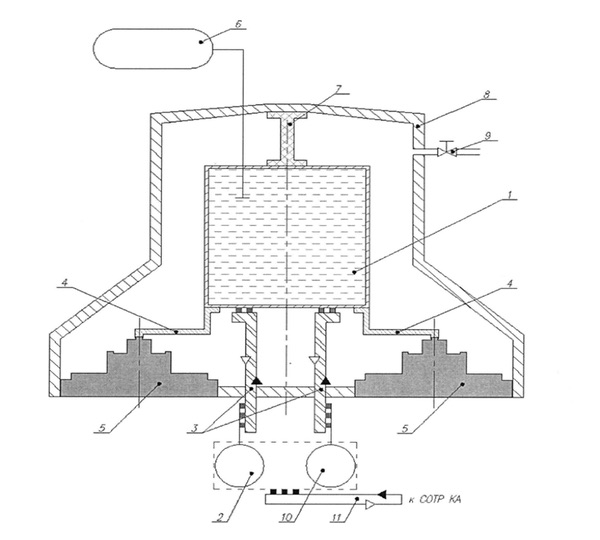 Schematic representation of Tundra’s cryogenic cooling system from a 2016 patent. The two Stirling cryocoolers are in positions 2 and 10, the cryostat (containing argon) in position 1 and the imaging detectors in position 5. Source |
A secondary payload for Tundra is called Balka and is produced by the Scientific and Industrial Corporation “Precision Instrument Systems” (NPK SPP). An article in a corporate newsletter of NPK SPP describes its successful testing on the first Tundra satellite, but does not reveal its purpose.[17] As can be determined from another source, Kometa awarded a contract for Balka (also referred to as “Product 16”) to NPK SPP on July 1, 2000 (again, before the official start of EKS), and the instrument has photodetectors called A-181A and A-181B developed by NPP Pulsar.[18]
The same detectors are also part of NPK SPP payloads flown on Russia’s Glonass navigation satellites that are named BAL-M (for Glonass-M), BAL-K (for Glonass-K), and BAL-K2 (for Glonass-K2). Their main purpose is to monitor the observance of nuclear test ban treaties by looking for signs of nuclear explosions. They perform the same role as the Nuclear Detection System flown on America’s GPS/Navstar satellites and the Defense Support Program (DSP) early warning satellites. Russia has clearly followed the same path by installing such sensors both on its navigation and early warning satellites. According to one article published by NPK SPP, another goal of the payloads is to observe gamma ray bursts, cosmic and galactic radiation, corpuscular radiation emitted by the Sun, lightning, volcanic activity, and “technogenic catastrophes”.[19]
The overall name of the Glonass-based nuclear detection system, which also has a ground-based segment to receive the information, is Lira-M. The name of the EKS-based system may be Altair.[20] One paper published in 2013 said the two systems would be integrated with ground-based nuclear detection systems of the Strategic Missile Forces. The EKS payload was supposed to include a gamma-ray detector and two optical detectors operating in slightly different wavelengths. It would use more efficient communication channels and be more advanced than the Glonass-based system, allowing a single satellite to determine the coordinates of a nuclear blast with high accuracy. The paper referred to both the HEO and GEO satellites, suggesting the nuclear detection payloads will be carried by both.[21]
The geostationary satellites
The geostationary EKS satellites will be launched from Plesetsk by the Angara-A5 rocket. Development of the Angara launch vehicles began right after the collapse of the Soviet Union with the aim of replacing the venerable Proton rockets that can fly only from Baikonur in Kazakhstan. After years of delays, the Angara-A5 made its inaugural flight in December 2014, after which it took another six years to launch the second one. Both rockets placed dummy payloads into geostationary orbit using the Khrunichev Center’s Briz-M upper stage, which uses storable propellants. However, the geostationary early warning satellites will require the use of a new upper stage called 14S48 or Persei, which is a modified version of RKK Energiya’s Blok-DM-03 upper stage burning liquid oxygen and kerosene. The Angara infrastructure at Plesetsk has been modified to support launches of the geostationary early warning satellites with the new upper stage.[22] One source told the TASS news agency in May 2016 that a single Angara-A5 could orbit “two to three” early warning satellites, but two would be the absolute limit considering the payload capacity of the Angara-A5 from Plesetsk.[23]
| The deployment of the geostationary EKS constellation will require the expansion of the ground control network. |
There are strong indications that the geostationary satellites will be equipped with a new payload. Unlike the vidicon-based staring sensor carried by the HEO satellites, this will be a scanning system with a new generation of infrared detectors. Work on new infrared detectors for EKS got underway on August 1, 2012, with a contract signed between the Ministry of Defense and Kometa for a research and development project called Kosmos-IK1 (“IK” is the Russian abbreviation for “infrared”). One document links this project to “the complete EKS constellation“ as well as the project’s “third phase”, which in other documentation is associated with the geostationary satellites.[24]
The research work resulted in Kometa awarding a contract for the new detectors (known as Granat-128) on November 28, 2016, to NPO Orion, which also supplied the infrared detectors for the scanning payloads on the first- and second-generation early warning satellites. Some documents related to this contract refer to “the complete EKS constellation”. The Granat-128 detectors appear to be the subject of several technical publications by NPO Orion (although they are not mentioned there by name). They are mercury cadmium telluride (HgCdTe) detectors with a 1024x10 pixel array. The spectral range is given both as 1–3 microns and 2–3 microns.[25]
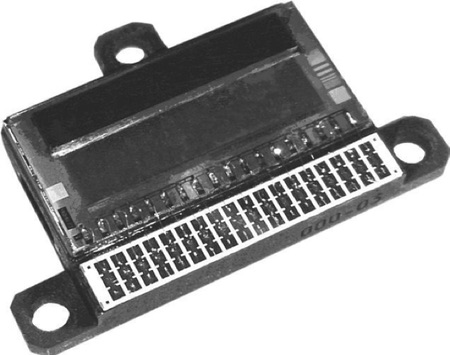 Picture of what likely is the Granat-128 infrared detector. Source |
NPO Orion and a company named NPP Vostok also act as subcontractors to Kometa for producing infrared detectors with larger pixel arrays under research projects called Progress and Komplekt-1 that were initiated in late 2015. However, this research was ordered not by the Ministry of Defense but instead by Roskosmos, and is probably unrelated to EKS. At least one of the detectors is said to be intended to provide “a global view of Earth, near-Earth space and distant space”, but as of now they cannot be tied to any specific satellite projects.[26]
The optical part of the EKS scanning payload is presumably described in an article written in 2016 by Kometa specialists, some of whom are veterans of the Vavilov State Optical Institute (GOI) that built the infrared scanning systems for the Soviet early warning satellites. The article says the scanning system is intended for “Earth monitoring in the interests of national surveillance” and compares it to the scanning sensor flown on the latest generation of American early warning satellites (SBIRS: Space-Based Infrared System). It refers to a paper on NPO Orion’s 1024x10 infrared detectors. The new scanning payload uses a readout technique called “time delay integration” (TDI) and has a beryllium mirror coated with gold to improve reflection in the infrared range. It has a global view and can scan the Earth’s disk in 4.2 seconds. [27]
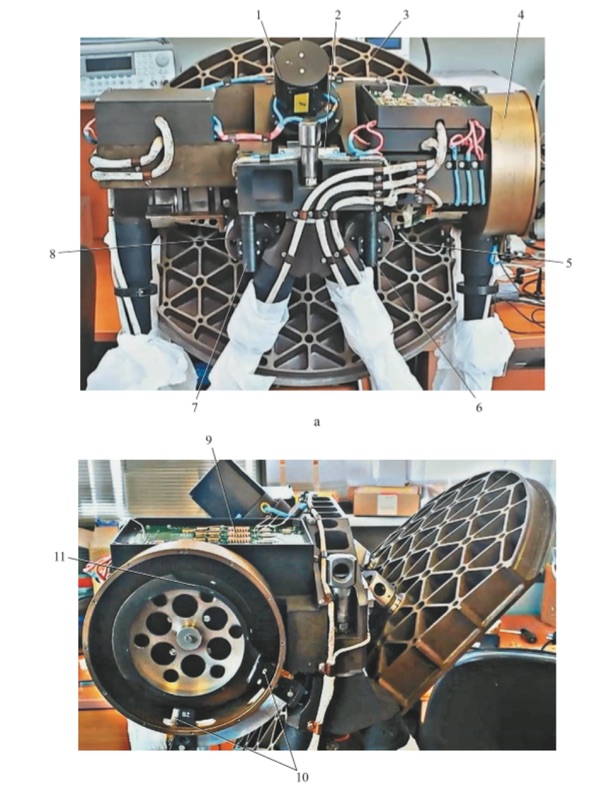 Infrared scanning payload for EKS. The scanning mirror is seen in position 3. Source |
Future EKS satellites may also carry an ultraviolet payload, although it is not known if this is specifically intended for the geostationary satellites. A handful of papers published by TsNII Elektron in 2014 to 2016 said that EKS was one of several programs to use UV photodetectors built by the company under a research project known as Fotik-4. The CCD-based photodetectors (called FPU-4P and FPU-4A) have 768x580 and 1024x1024 pixel arrays and operate in the UVC part of the ultraviolet spectrum, which is almost completely absorbed by the ozone layer. This means that such sensors (also called “solar-blind photodetectors”) can easily spot missile plumes due to the absence of a terrestrial background signature. One of the papers also mentions the possibility of using them to detect hypersonic vehicles. The Fotik-4 project ran from 2011 to 2014, but so far there is no evidence that its results were implemented in the EKS project. Another ultraviolet instrument with a probable missile detection role was concurrently developed under a secretive Roskosmos project named UFIK, which is not known to have any ties with EKS [28].
Other work related to the third phase of EKS is called LSS-GSO and involves a system called 15E1818 developed jointly by NPO Impuls and NPK SPP.[29] This could well be a laser communications system to be used for intersatellite links and/or high-speed downlink of data (with “LSS” and “GSO” being the likely Russian abbreviations for “laser communications system” and “geostationary orbit”). NPK SPP is no newcomer to that field, having already built a laser communications system to beam data from the Persona optical reconnaissance satellites to the Geyzer military data relay satellites. One potential use of the system could be for the satellites to quickly exchange data obtained by their nuclear detection payloads. An earlier mentioned paper on the nuclear detection payloads (see source 21) noted that an intersatellite laser communications system would be a possible way of increasing the accuracy of the observations.
The deployment of the geostationary EKS constellation will require the expansion of the ground control network. This currently relies on a ground control facility near Kurilovo some 70 kilometers southwest of Moscow. Built back in the Soviet days, it is known as the “Western Control Station” (ZMKP) and the place where it is situated is also known as Serpukhov-15. It actually consists of two ground control stations located about one kilometer from each other. One (called “Object 455”) was originally constructed to track the HEO satellites as they reached their apogee over the Atlantic and the other (named “Object 455I”) to control GEO satellites stationed over the Atlantic. Both were upgraded in the past few years to support the EKS program and are together referred to as “Object 455/E”.[30]
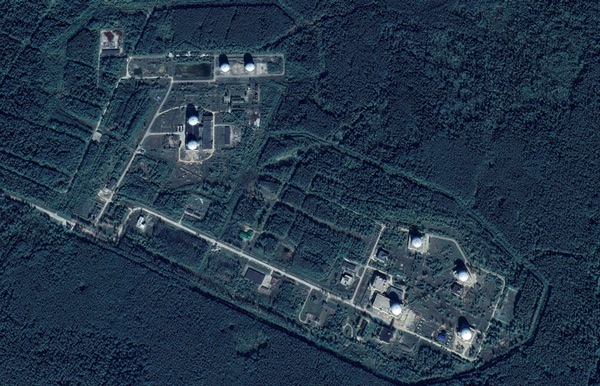 The two ground control facilities of “Object 455” at Serpukhov-15, each of which has several radomes. The site on the right was originally built for the Soviet HEO early warning satellites and the one on the left for GEO satellites. Source: Google Earth. |
The geostationary constellation should also include one or more satellites to keep an eye on the Pacific region, which is an important patrol zone for America’s Trident II submarine-launched ballistic missiles. These satellites will not be visible from Serpukhov-15 and will have to rely on an Eastern Control Station (VMKP), also known as “Object 485”, near Gaiter in the Khabarovsk region in Russia’s Far East. This was constructed to support the second-generation geostationary satellites, but was never used to full capacity at the time. Work to modify the facility for EKS (under the name “Object 485/E”) was ordered in 2013, but recently published documentation indicates it has not yet been finished.[31]
Deploying the EKS constellation
As for most of Russia’s new-generation military satellites, the road to the launch pad for EKS turned out to be long and arduous. The earliest announced plans called for the launch of the first HEO and GEO satellites in 2007 and 2009, but these and many later target dates went by without any launches. The numerous delays in the EKS program left Russia’s early warning network without any operational satellites following the retirement of the final first-generation and second-generation satellites in 2014.
| Ozar also disclosed that the EKS constellation had reached its “minimum baseline configuration”, suggesting the four satellites can ensure round-the-clock coverage of the most critical areas. |
The first EKS/Tundra satellite, officially announced as Kosmos-2510, was finally launched from Plesetsk on November 17, 2015. Three more launches followed on May 25, 2017 (Kosmos-2518), September 26, 2019 (Kosmos-2541) and May 22, 2020 (Kosmos-2546). The satellites were all placed into highly elliptical 12-hour Molniya-type orbits with perigees ranging from about 1,400 to 2,000 kilometers, an apogee around 38,000 kilometers and an inclination of about 63 degrees. The satellites have two daily apogees during which they spend several hours hovering high above the Northern hemisphere. One is located approximately over Greenland and the other above Russia’s Far East. Since the eastern control center for EKS does not appear to be ready yet, the satellites probably only perform observations from the “western” apogee. This is situated farther to the west than that of the Soviet HEO satellites. Apparently, they are capable of detecting missile launches from both the North American continent and the Atlantic Ocean against the background of Earth. This is corroborated by a statement from RKK Energiya general director Igor Ozar, who said last August that the HEO satellites can see ballistic missile launches from both continents and oceans.[32]
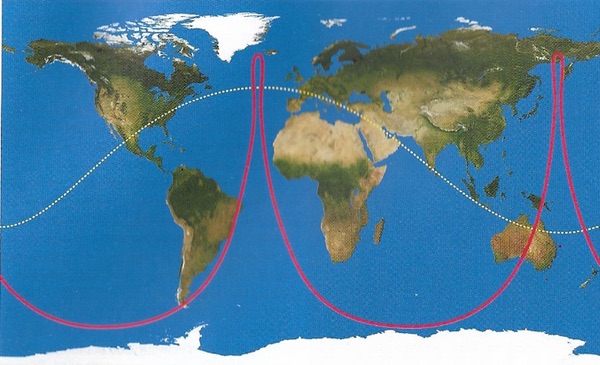 Ground track of the first Tundra satellite. Source: Novosti Kosmonavtiki magazine. |
Ozar also disclosed that the EKS constellation had reached its “minimum baseline configuration”, suggesting the four satellites can ensure round-the-clock coverage of the most critical areas. Late last year, Defense Minister Sergei Shoigu announced that with the fourth launch the second phase of the deployment of EKS had been completed.[33] According to a Kometa article published in 2017, the first phase had ended in late 2015, indicating that its objective was to complete in-orbit tests of the first satellite.[34]
Even though the third phase has been associated with the geostationary satellites, it is clear that more of the HEO satellites will be launched in the coming years. In an announcement on the first Tundra launch in November 2015, the Ministry of Defense said the ultimate goal was to have a constellation of ten satellites, a number also mentioned by a handful of other sources.[35] According to a source quoted by the TASS news agency in February 2017, all these satellites would be orbited by the Soyuz-2 rocket, meaning this number does not include any of the geostationary satellites.[36] This amount of satellites would make it possible to prevent gaps in coverage due to the loss of a single satellite and reduce the risk of false alarms by simultaneously monitoring the same area from different satellites. In the Soviet days, the maximum amount of simultaneously operating HEO satellites was nine.
The geostationary satellites are clearly lagging far behind. One source told the Interfax news agency in May 2016 that they had not yet been manufactured and information provided in RKK Energiya’s annual report for 2017 suggested that the satellites (misleadingly called “geostationary communications satellites”) were still in the design phase at the time.[37] With the introduction of the new infrared scanning system, the payload module may be significantly different from that of Tundra. It will probably be integrated by an affiliate of Kometa called the Experimental Production and Technical Center (OPTTs), where several buildings are known to be undergoing modifications to support the third phase of EKS.[38] According to Kometa’s annual report for 2015, those same buildings would be modified to build payload modules and ground support equipment for EKS.[39]
Aside from possible problems with the new payload module, the construction of the satellites is likely also hampered by Western economic sanctions that have had a major impact on the delivery of electronic parts to the Russian space industry. What may have further contributed to possible delays is the fact that the only other geostationary satellite using RKK Energiya’s UKP platform was crippled by a power failure only days after its launch in December 2017. This was a communications satellite for Angola (AngoSat 1) that had been designed for a 15-year mission. Having lost its confidence in RKK Energiya’s platform, Angola later turned to another Russian satellite manufacturer (ISS Reshetnev) to build a replacement satellite.
Other complicating factors are continuing delays in the manufacture of Angara-A5 rockets (caused in part by the opening of a new production facility in Omsk, Siberia), as well as the need to use the new Persei upper stage, even though that is a modification of the tried-and-tested Block-DM upper stage. Last August, Roskosmos chief Dmitriy Rogozin said the upper stage was expected to make its debut on the third Angara-A5 mission in 2021, but that the payload had not yet been determined.[40] Even in the unlikely event that the first geostationary EKS satellite would be ready by then, the Russians are unlikely to risk flying a high-priority military satellite on the first mission of a new upper stage.
Speaking in an interview last summer, the commander of Russia’s Aerospace Forces, Sergei Surovikin, said the deployment of the EKS constellation was expected to be completed in 2024. He also mentioned a “high-orbiting space reconnaissance system” that would begin deployment in 2023, but it is not clear if this was a veiled reference to the geostationary EKS satellites or a totally different project.[41] Even if the 2024 target date pertains only to the HEO satellites, the goal of orbiting six more Tundra satellites in the coming three years may be overly optimistic considering the big backlog in Russian military space launches.
Capabilities
The few Russian officials who have spoken out on Tundra have had nothing but praise for the system. Speaking to the Russian news agency TASS after the fourth Tundra launch in June 2020, an anonymous source in Russia’s military-industrial complex said the constellation can detect the launch of any ballistic missile or space launch vehicle from US territory. He added that the satellites are equipped with “infrared sensors of a new generation”, making it possible to detect with high precision the launch of rockets against the background of the Earth’s surface and to follow the flight trajectories of ballistic missiles and predict the impact zones of their warheads in the automatic mode.[42]
| When placing EKS on an equal footing with SBIRS, Krivoruchko must have been talking about EKS in its final configuration. In terms of the sheer number of available sensors, SBIRS currently far exceeds EKS. |
In an interview published in December 2019, Deputy Defense Minister Aleksei Krivoruchko claimed EKS can detect not only launches of intercontinental and submarine-launched ballistic missiles, but also of intermediate range missiles, short range missiles and space rockets. He said that at the time it had already detected 64 launches of ballistic missiles (including 35 non-Russian missiles) and 136 space launches (including 97 non-Russian launches). Krivoruchko described EKS “as good as” America’s Satellite-Based Infrared System (SBIRS) and “unique” in its ability to relay information in real time to the country’s leadership and the Armed Forces.[43]
When placing EKS on an equal footing with SBIRS, Krivoruchko must have been talking about EKS in its final configuration. In terms of the sheer number of available sensors, SBIRS currently far exceeds EKS. It consists of four GEO satellites each carrying both a scanning and staring sensor and three scanning sensors hosted on HEO satellites. In addition to that, some of the older DSP geostationary early warning satellites are also still operational. By comparison, EKS has four HEO satellites with a staring sensor that likely uses 20th century vidicon technology rather than the proclaimed “infrared sensors of a new generation”.
The SBIRS scanning sensor is intended for continuous observation and surveillance of traditional intercontinental ballistic missile threats, while the staring sensor, which has a relatively small field of view, is designed to detect very low signature, short-burn-duration theater missiles. Possibly, the Irtysh-E camera is supposed to accomplish similar tasks in its wide-angle and narrow-angle mode, but it is hard to say whether it can do this as effectively as the combination of sensors flown on the American satellites.
Much also hinges on its ability to distinguish missile plumes against the background of an illuminated Earth, which was a major problem for the Soviet-era satellites. Although the cryogenically cooled Irtysh was designed back in the 1980s to address that issue, it is impossible to tell if its modernized version lives up to those expectations. As pointed out earlier, the current orbital configuration of the Tundra constellation does indicate that the satellites are designed to see missile launches from the North American continent and the Atlantic Ocean against the backdrop of Earth. The fact that they have also observed many Russian launches is further confirmation of that. It may seem odd that the Russians use their early warning satellites to watch their own launches, but this actually continues a practice begun with the Soviet satellites, which also regularly observed domestic missile and space launches to calibrate and test onboard sensors.
The current EKS constellation clearly does not have the global coverage provided by SBIRS. At least one critical area that does not seem to be covered is the Pacific. This will have to wait until the eastern control center reaches operational status. Although the HEO satellites could theoretically observe this region from their eastern apogee, the Russians may elect to do this with one or more of the GEO satellites. In short, it is probably safe to say that the Russians will need to deploy their full constellation of HEO and GEO satellites with a combination of staring and scanning sensors to match the capabilities of SBIRS.
It should not be forgotten that the satellites are only one element of the country’s early warning system. Russia also possesses a large network of ground-based early warning radars which has been spectacularly upgraded in the past 15 years or so to provide coverage of all potential attack zones, a capability achieved not even in the Soviet days. Constituting the backbone of Russia’s modernized early warning network are Voronezh-type radars that are made of standard prefabricated elements and can be built in a relatively short time. Seven have been constructed since 2005 and several more are expected to become operational in the coming years. The network is also being expanded with over-the-horizon radars called Konteyner.
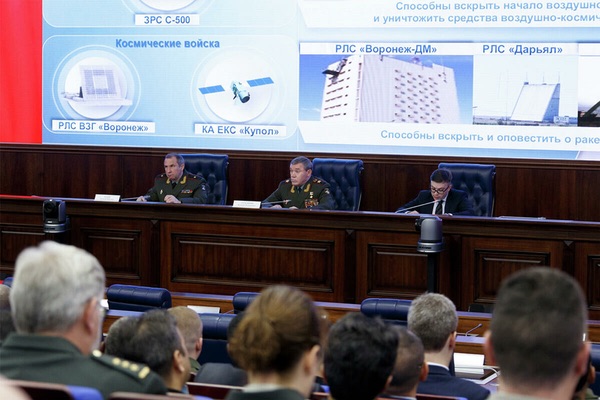 Ground-based and space-based elements of Russia’s early warning network shown during a Ministry of Defense briefing in December 2019. Source |
The main benefit of the satellites is that they can spot missiles as soon as they are launched and before they enter the visibility zone of the radars, giving additional warning time. In some scenarios though, such as for missiles launched from submarines in the Atlantic, satellites don’t add very much to that warning time. The relatively sluggish pace of the EKS program may even be a sign that the satellites take a backseat to the ground-based early warning network. Aside from their early warning role, they also serve as intelligence tools, collecting data on foreign weapon activity and testing in order to assess weapons deployment, tactics and technical characteristics. Whenever it is completed, the EKS constellation will further strengthen an already robust early warning capability.
References
- A detailed history of Soviet/Russian early warning satellites can be found in a three-part article written by the author and published in Quest: The History of Spaceflight Quarterly in 2018.
- The date for the contract between Kometa and RKK Energiya is from procurement documentation (in Russian) published in October 2020. Some sources claim RKK Energiya received the contract directly from the Ministry of Defense on July 31, 2007, but this was for another military project called OREST, possibly related to electronic warfare.
- Universal Space Platform page on the RKK Energiya website.
- Court documentation (in Russian) published in 2019.
- Court documentation (in Russian) published in 2017 ; Article (in Russian) published in “Vestnik NPO Lavochkina”, 2017/2, p. 162.
- A former version of OKB Fakel’s website said “thruster modules with SPD-100 engines” are flown on board Kosmos-2510 and 2518, the first two Tundra satellites.
- Court documentation (in Russian) published in 2014.
- Procurement documentation (in Russian) published in February 2014, November 2015 and September 2020. Documentation specifically linking this work to EKS is no longer available online.
- Procurement documentation (in Russian) published in January 2014.
- Collection of articles (in Russian) published on the occasion of NIIT’s 80th anniversary in 2015, p. 3, 8.
- Procurement documentation (in Russian) published in September 2014, October 2015, February 2017 and June 2017.
- Paper (in Russian) presented by TsNII Elektron at a conference in 2010, p. 7.
- Summary of PhD dissertation (in Russian) published in 2001.
- Paper (in Russian) published by specialists of Kometa and NPP Vostok in 2016.
- KB Tochmash press release (in Russian), October 6, 2017.
- Patent (in Russian) published by KB Tochmash in 2016 (English machine translation available).
- NPK SPP newsletter (in Russian) published in December 2016, p. 2.
- Procurement documentation (in Russian) published in June 2014.
- Article (in Russian) published by NPK SPP in 2013.
- NPK SPP report (in Russian), 2016, p. 30.
- Paper (in Russian) presented at a conference in 2013.
- Procurement documentation (in Russian) published in December 2018.
- TASS report (in Russian), May 13, 2016.
- Court documentation (in Russian) published in 2017.
- Procurement documentation (in Russian) published in September 2017 ( 1, 2, 3, 4) ; Papers (in Russian) published in 2014 and 2016.
- A 2000x2000 pixel array infrared detector developed under Komplekt-1 can be seen in this presentation of the Rzhanov Institute of Semiconductor Physics published in November 2018, p. 21.
- Article (in Russian) by Kometa specialists published in “Vestnik Kontserna VKO Almaz-Antei”, 4/2016.
- Article (with English translation) published by TsNII Elektron in 2014 ; Conference papers (in Russian) presented in 2014 (p. 14) and 2016 ; UFIK thread on the NASASpaceflight Forum.
- Court documentation (in Russian) published in 2018 ; Procurement documentation (in Russian) published in September 2014(a), September 2014(b) and October 2014.
- Court documentation (in Russian) published in 2016 and 2019.
- Planning documentation for Object 485 (in Russian) published in 2018 ; Procurement documentation (in Russian) published in June 2019 and December 2019.
- TASS report (in Russian), August 5, 2020.
- Transcript (in Russian) of a speech given by Defense Minister Sergei Shoigu on December 21, 2020.
- Article (in Russian) published in “Vozdushno-kosmicheskiy rubezh”, August 2017, p. 41.
- Ministry of Defense report (in Russian), November 17, 2015.
- TASS report (in Russian), January 13, 2017.
- Interfax-AVN report (in Russian), May 14, 2016 ; RKK Energiya annual report, 2017, p. 33.
- Procurement documentation (in Russian) published in December 2020.
- Kometa’s annual report for 2015 can be downloaded here.
- Interview (in Russian) with Dmitriy Rogozin, August 25, 2020.
- Interview (in Russian) published in Krasnaya Zvezda, July 3, 2020.
- TASS report (in Russian), June 4, 2020.
- The interview was published by Krasnaya Zvezda on December 28, 2019, but the information given by Krivoruchko on EKS was soon removed. It was, however, picked by up by other Russian news outlets, such as Rossiyskaya Gazeta.
Note: we are temporarily moderating all comments submitted to deal with a surge in spam.
